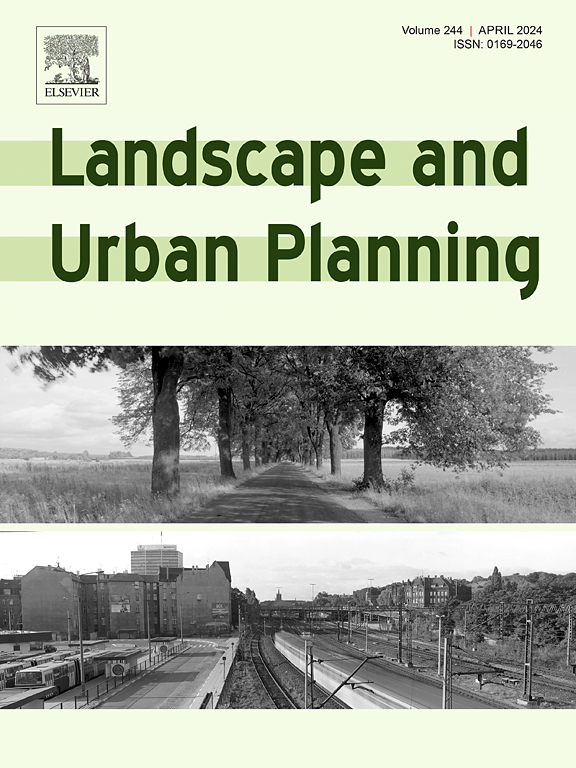从 "以地为本 "到 "以人为本":中国城郊公园的时空降温效应及其驱动因素
IF 7.9
1区 环境科学与生态学
Q1 ECOLOGY
引用次数: 0
摘要
城郊地区是人类居住的重要场所,也是改善热环境的重要绿地,尤其是在城市用地有限的情况下。了解影响城郊公园降温强度的因素,对于指导适应气候的城市规划和管理决策至关重要。然而,相关研究一般侧重于城市公园的短期降温效果,而很少分析公园年龄等 "以人为本 "的社会人口因素的影响。本研究重点对 2000 年至 2021 年中国城市周边的 647 个国家森林公园进行了全面的时空分析。研究考虑了三类驱动因素:公园形态、景观格局和社会人口特征。研究结果表明:(1)与城市公园相比,城郊公园的几何形态对降温强度的影响有限。(2)公园内的景观格局对降温强度有显著影响。公园内林地比例逐年增加,耕地对降温强度的负面影响从 2000 年的-4.788 降至 2021 年的-0.547。此外,不透水地面的负面影响也在增加,系数从 2000 年的-1.022 下降到 2021 年的-1.877。(3) 当公园年龄在 31 至 35 岁之间时,公园年龄对降温强度有明显的促进作用。 (4) 人均 GDP 和人口密度的增加与降温强度的减弱相关。(5) 异质性分析结果显示,不同气候区的公园在降温效果上存在差异。结合蓝色和绿色空间的城郊公园表现出更明显的降温效果。这些研究成果为中国公园和生态系统的设计、规划和管理提供了有价值的见解,可以增强城市气候适应能力,提高城市居民的福祉。本文章由计算机程序翻译,如有差异,请以英文原文为准。
From land-based to people-based: Spatiotemporal cooling effects of peri-urban parks and their driving factors in China
Peri-urban areas are essential for human habitation and provide significant green spaces to improve the thermal environment, especially when urban land is limited. Understanding the factors influencing the cooling intensity of peri-urban parks is crucial for guiding decision-making in climate-responsive urban planning and management. However, relevant studies generally focus on the short-term cooling effect of urban parks, and the effect of “people-based” socio-demographics, such as park age, have rarely been analyzed. This study focuses on a comprehensive spatiotemporal analysis of 647 national forest parks in urban peripheries across China from 2000 to 2021. It considers three categories of driving factors: park morphology, landscape patterns, and social demographic characteristics. The findings reveal that (1) In contrast to urban parks, the geometric morphology of peri-urban parks has limited influence on cooling intensity. (2) The landscape pattern within the park significantly affects the cooling intensity. The proportion of woodland in the park increases year by year, and the negative impact of cropland on the cooling intensity decreases from −4.788 in 2000 to −0.547 in 2021. Besides, the negative impact of impervious surfaces has increased, with the coefficient decreasing from −1.022 in 2000 to −1.877 in 2021. (3) Park age significantly promotes cooling intensity when the park is between 31 and 35 years old. (4) The increase in per capita GDP and population density are associated with diminishing cooling intensity. (5) Heterogeneous analysis results reveal variations in cooling effects among parks in different climate zones. Peri-urban parks that combine blue and green spaces exhibit a more pronounced cooling effect. These research outcomes offer valuable insights for designing, planning, and managing parks and ecosystems in China, which can enhance urban climate resilience and the well-being of urban residents.
求助全文
通过发布文献求助,成功后即可免费获取论文全文。
去求助
来源期刊

Landscape and Urban Planning
环境科学-生态学
CiteScore
15.20
自引率
6.60%
发文量
232
审稿时长
6 months
期刊介绍:
Landscape and Urban Planning is an international journal that aims to enhance our understanding of landscapes and promote sustainable solutions for landscape change. The journal focuses on landscapes as complex social-ecological systems that encompass various spatial and temporal dimensions. These landscapes possess aesthetic, natural, and cultural qualities that are valued by individuals in different ways, leading to actions that alter the landscape. With increasing urbanization and the need for ecological and cultural sensitivity at various scales, a multidisciplinary approach is necessary to comprehend and align social and ecological values for landscape sustainability. The journal believes that combining landscape science with planning and design can yield positive outcomes for both people and nature.
 求助内容:
求助内容: 应助结果提醒方式:
应助结果提醒方式:


